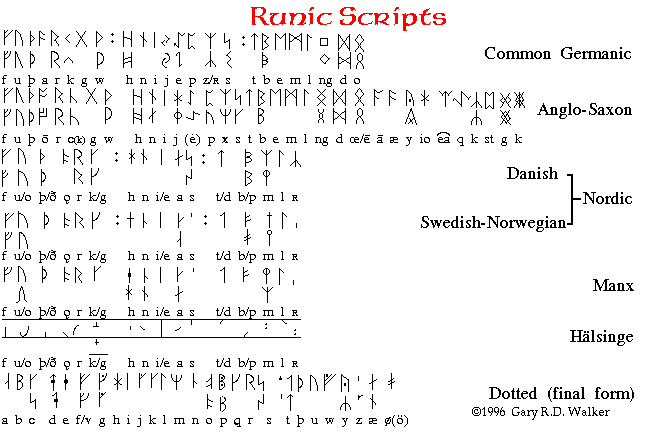
This page is still under construction.
Note first the distinction between the older (Old Germanic) and younger (Old Norse) inscriptions. The known inscriptions in the Common Germanic or Elder Futhark (or alphabet) of 24 runes date from about the 2nd century until about the seventh century A.D. These inscriptions are in a variety of germanic languages including Gothic and Proto-Norse. These inscriptions may occur wherever Germanic peoples travelled or settled. These inscriptions occur on a variety of artefacts including spear points, jewelry, stones. These inscriptions are relatively rare.
In England, after the Anglo-Saxon invasion (c450 A.D.), the older futhark developed through Frisian into the Anglo-Saxon Futhorc, with a gradual increase in the number of runes. These inscriptions are in Old English (Anglo-Saxon).
In Scandinavia, from about 800 A.D. on, the Nordic or Younger futhark arose, based on a simplification of the elder futhark with only 16 characters. This Nordic futhark has a fair number of variations, but all based upon a central originating model. From the 10th century on this futhark was gradually extended by the addition of "dotted runes" to reduce ambiguity.
Many of the surviving inscriptions of runes are found on stones. This seems to represent a fad particularly in the 11th century Uppland area of Sweden. Inscriptions on other materials are also common. For instance over 500 inscriptions of post-11th C date were found during the Bryggen excavation in Bergen, Norway. These rúnakefli have been found from many locations though rarely (perhaps due to the survival rate of wood). Inscriptions in the Nordic futhark are primarily in Old Norse (and its later derivatives such as Old Swedish), but a few are in Latin. The inscriptions cover the breadth of purposes to which writing may be used: advertising, correspondence, memorial, magic, ownership, religion, etc.
Please note: "The Vikings" did not use the Elder Futhark!

Runes continued to be used long after the Viking Age. There is little evidence to support the notion that the church suppressed runic systematicly. Current evidence seems to make it likely that it gradually disappeared under the economic influence of the Hansa and european culture in general.
Is there evidence for the Norwegians, Swedes, or Danes placing runes on weapons? On swords in general, yes there are a few examples, but they are unusual. There's one from Korsodegarden, Norway c 1100-50 with the inscription 'Asmund made me, Asleik owns me' on one of the grip mounts. There's a strap-end from Greenmount, Ireland c 1100 with the inscription 'Domnall Sealshead owns the sword' (tomnalselshofothasoertheta = Domnal Selshöfða swerðeð á. I do remember seeing a sword with a runic inscription on the blade, but I can't find it in my notes at the moment. I think it might have been in one of Stephen's books which makes it suspect.
What would the proper norse be for "(Name) owns me"? Strictly speaking: (Name, nom. sing.) á mik. The period examples tend to be more often: (Name, nom. sing.) á (ala numerous Bergen examples (c late 12th-early 13th century); or: (Name, nom. sing.) á (object, acc. sing.) (ala the Hunterston Brooch, 10th c.); or: (Name, nom. sing.) á (object, acc. sing.) thessa (thasa) (ala the Ranveig's Shrine, c 1000); or just the name. In one of the younger futharks of course.
© copyright 1996, 2000 Gary R.D. Walker
Return to Medieval, Norse, or Ravensgard.
Last updated 2/4/00.
webmaster at ravensgard.org